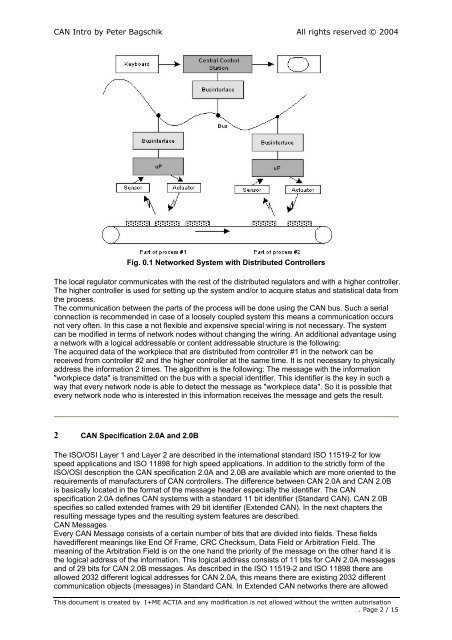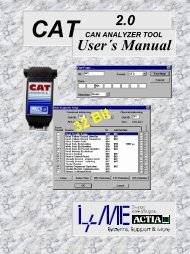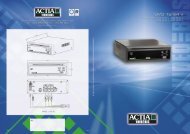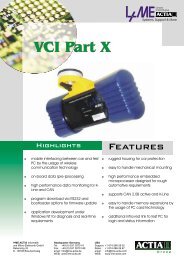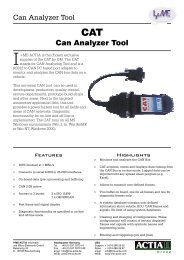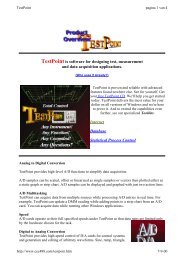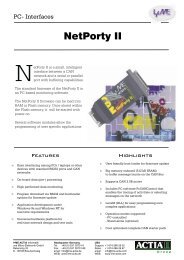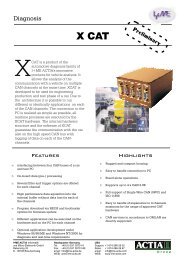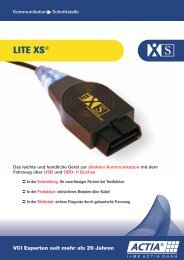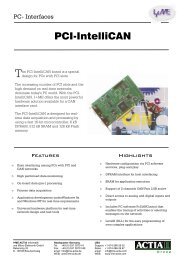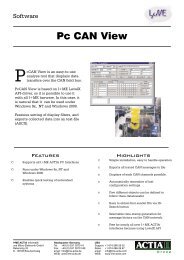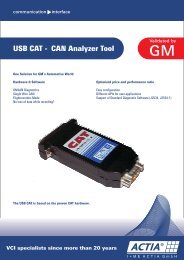An Introduction to CAN - I+ME ACTIA GmbH
An Introduction to CAN - I+ME ACTIA GmbH
An Introduction to CAN - I+ME ACTIA GmbH
Create successful ePaper yourself
Turn your PDF publications into a flip-book with our unique Google optimized e-Paper software.
<strong>CAN</strong> Intro by Peter Bagschik All rights reserved © 2004<br />
Fig. 0.1 Networked System with Distributed Controllers<br />
The local regula<strong>to</strong>r communicates with the rest of the distributed regula<strong>to</strong>rs and with a higher controller.<br />
The higher controller is used for setting up the system and/or <strong>to</strong> acquire status and statistical data from<br />
the process.<br />
The communication between the parts of the process will be done using the <strong>CAN</strong> bus. Such a serial<br />
connection is recommended in case of a loosely coupled system this means a communication occurs<br />
not very often. In this case a not flexible and expensive special wiring is not necessary. The system<br />
can be modified in terms of network nodes without changing the wiring. <strong>An</strong> additional advantage using<br />
a network with a logical addressable or content addressable structure is the following:<br />
The acquired data of the workpiece that are distributed from controller #1 in the network can be<br />
received from controller #2 and the higher controller at the same time. It is not necessary <strong>to</strong> physically<br />
address the information 2 times. The algorithm is the following: The message with the information<br />
"workpiece data" is transmitted on the bus with a special identifier. This identifier is the key in such a<br />
way that every network node is able <strong>to</strong> detect the message as "workpiece data". So it is possible that<br />
every network node who is interested in this information receives the message and gets the result.<br />
2 <strong>CAN</strong> Specification 2.0A and 2.0B<br />
The ISO/OSI Layer 1 and Layer 2 are described in the international standard ISO 11519-2 for low<br />
speed applications and ISO 11898 for high speed applications. In addition <strong>to</strong> the strictly form of the<br />
ISO/OSI description the <strong>CAN</strong> specification 2.0A and 2.0B are available which are more oriented <strong>to</strong> the<br />
requirements of manufacturers of <strong>CAN</strong> controllers. The difference between <strong>CAN</strong> 2.0A and <strong>CAN</strong> 2.0B<br />
is basically located in the format of the message header especially the identifier. The <strong>CAN</strong><br />
specification 2.0A defines <strong>CAN</strong> systems with a standard 11 bit identifier (Standard <strong>CAN</strong>). <strong>CAN</strong> 2.0B<br />
specifies so called extended frames with 29 bit identifier (Extended <strong>CAN</strong>). In the next chapters the<br />
resulting message types and the resulting system features are described.<br />
<strong>CAN</strong> Messages<br />
Every <strong>CAN</strong> Message consists of a certain number of bits that are divided in<strong>to</strong> fields. These fields<br />
havedifferent meanings like End Of Frame, CRC Checksum, Data Field or Arbitration Field. The<br />
meaning of the Arbitration Field is on the one hand the priority of the message on the other hand it is<br />
the logical address of the information. This logical address consists of 11 bits for <strong>CAN</strong> 2.0A messages<br />
and of 29 bits for <strong>CAN</strong> 2.0B messages. As described in the ISO 11519-2 and ISO 11898 there are<br />
allowed 2032 different logical addresses for <strong>CAN</strong> 2.0A, this means there are existing 2032 different<br />
communication objects (messages) in Standard <strong>CAN</strong>. In Extended <strong>CAN</strong> networks there are allowed<br />
This document is created by <strong>I+ME</strong> <strong>ACTIA</strong> and any modification is not allowed without the written au<strong>to</strong>risation<br />
. Page 2 / 15


